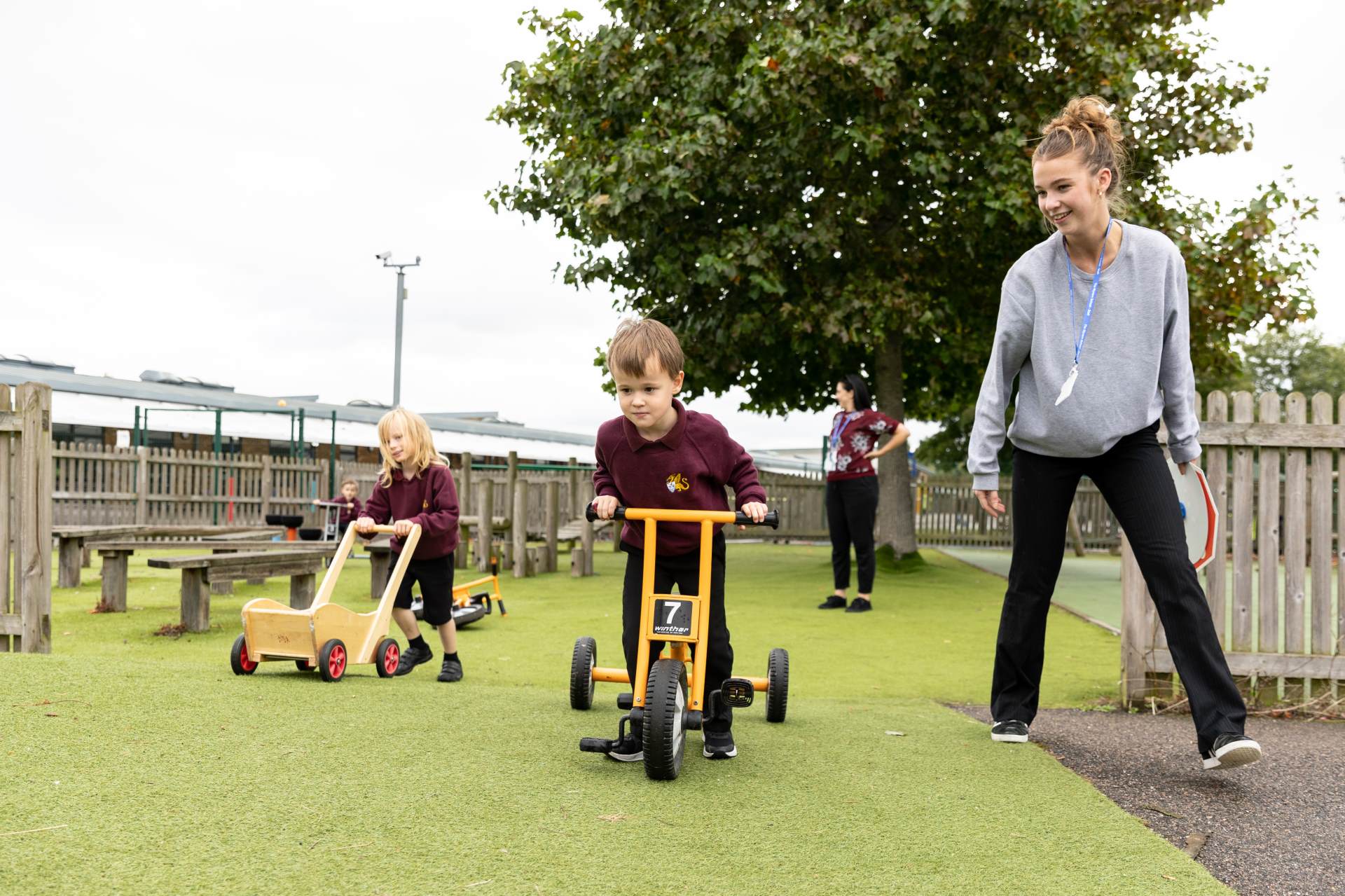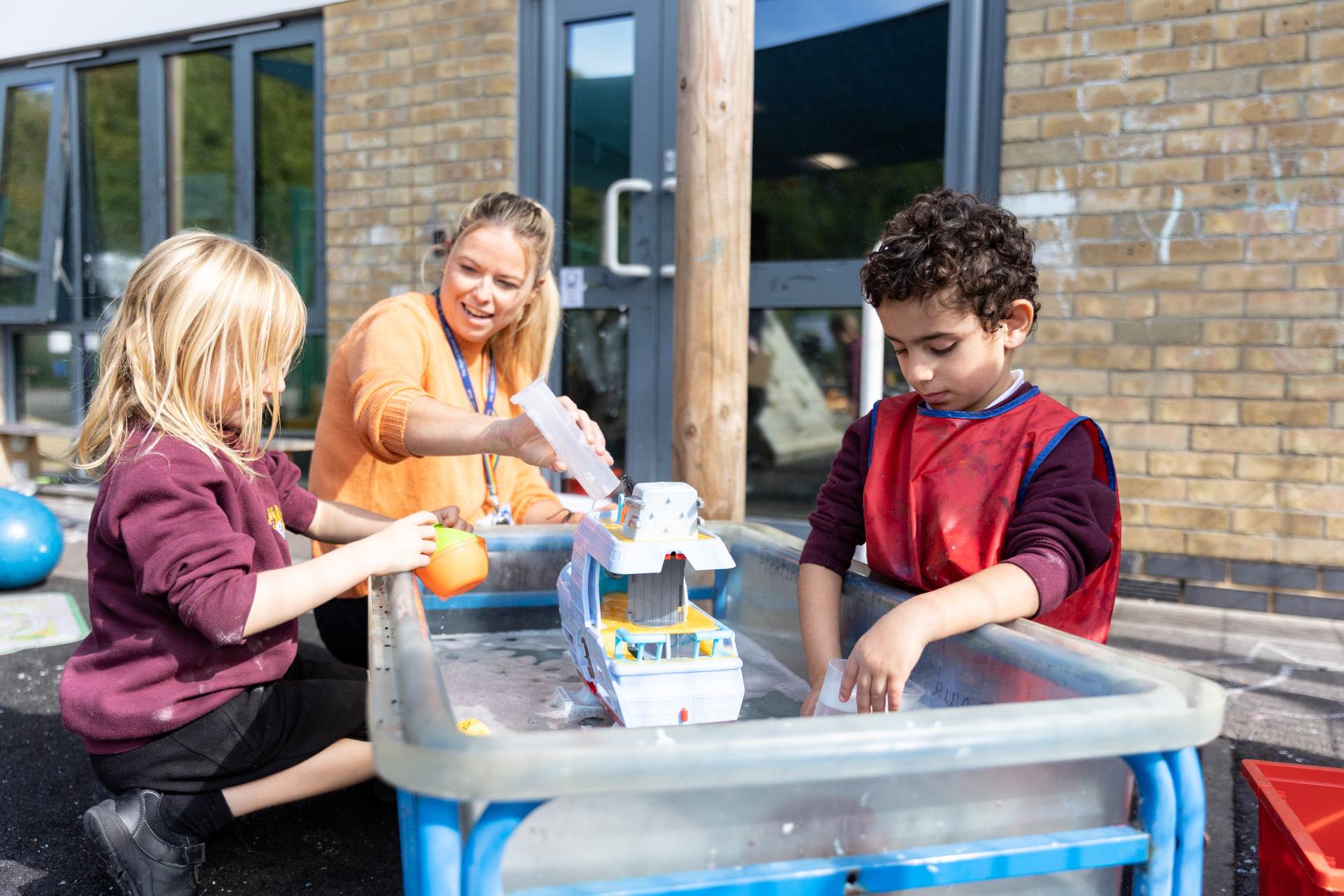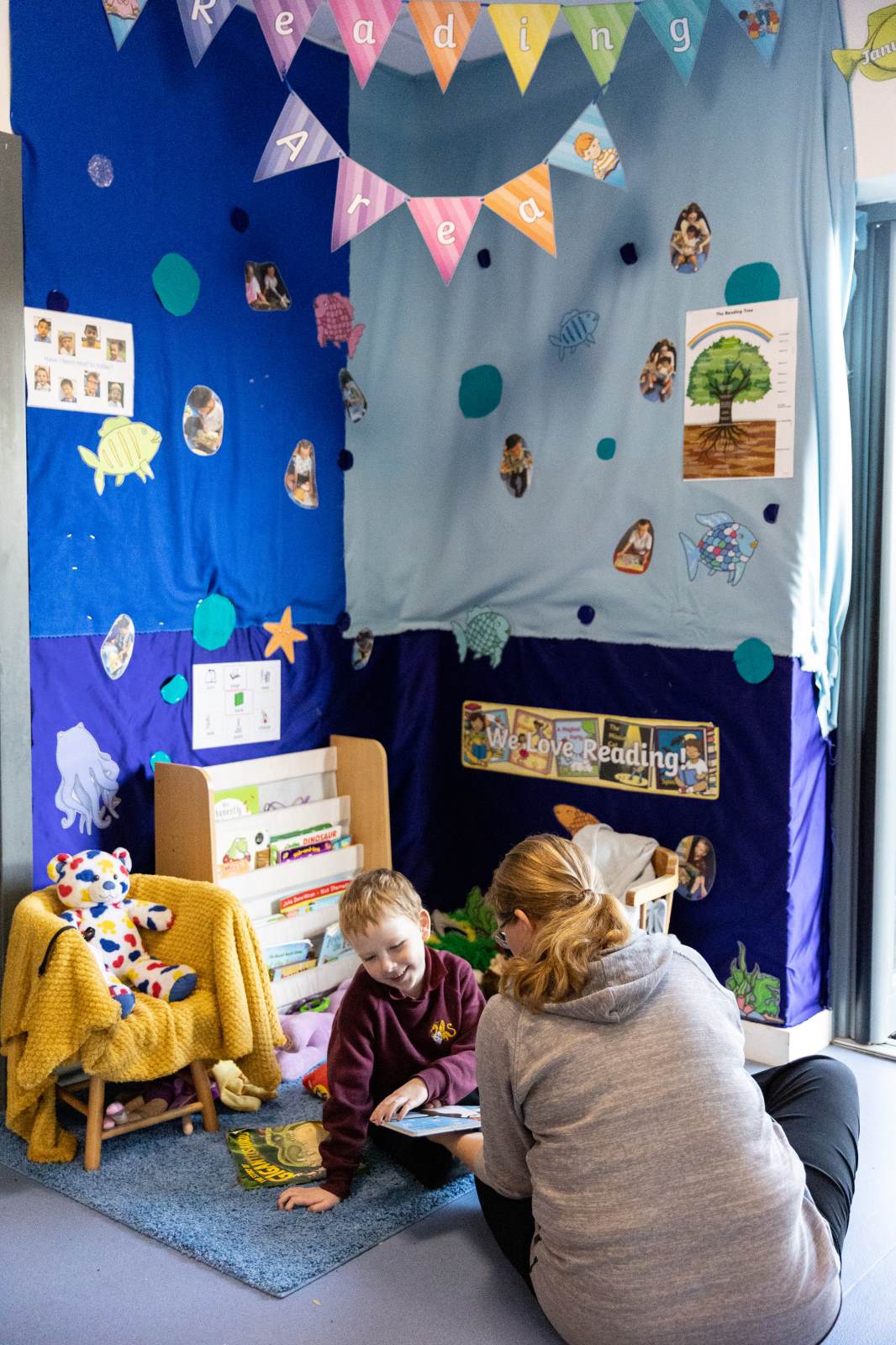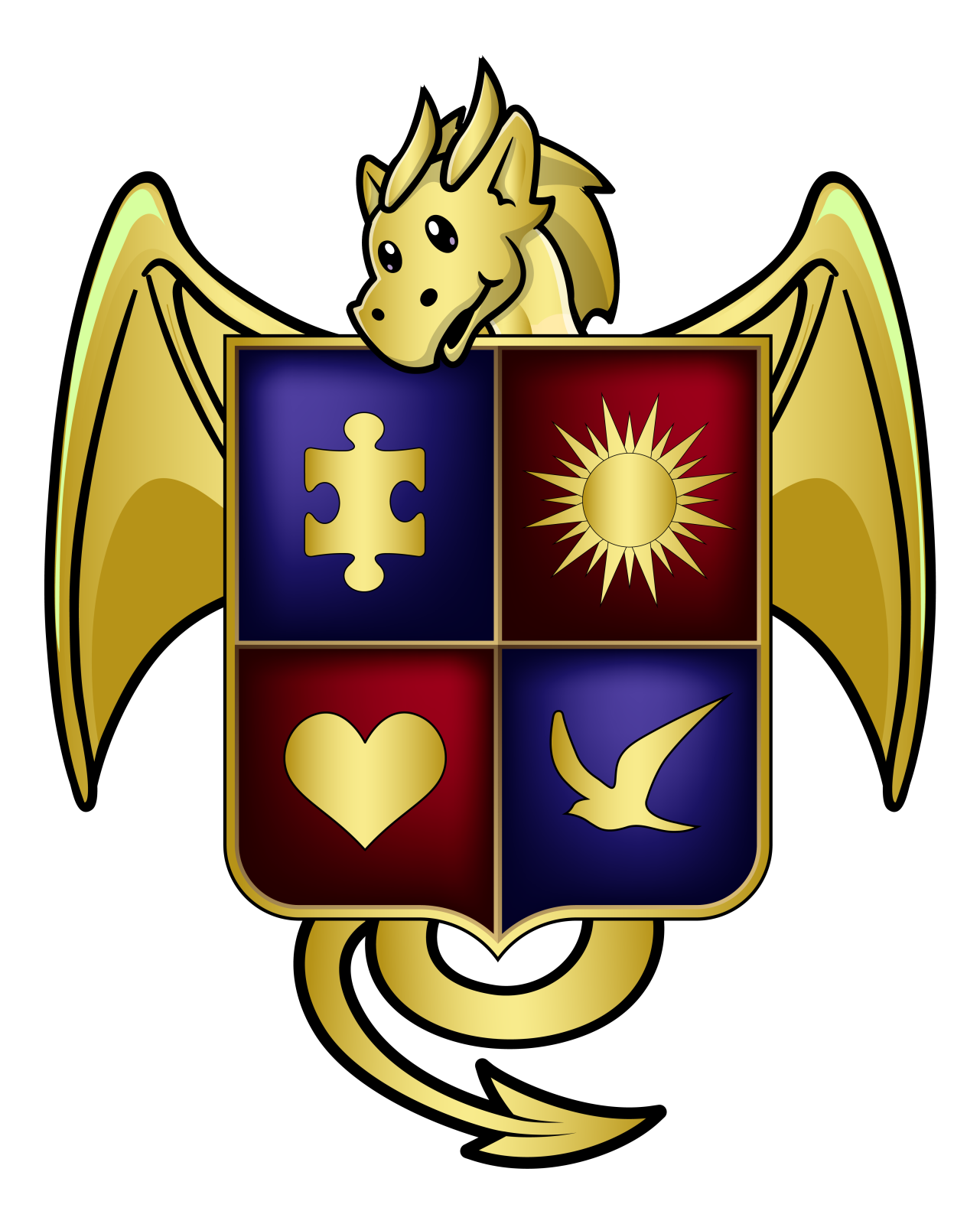EYFS Pathway

INTRODUCTION
Who is the EYFS Pathway for?Children in the EYFS pathway are the youngest learners in the school; ages range from 3 – 7years. Children have a range of presenting needs this includes, Autism (ASC), Complex learning needs, Severe Learning Difficulties (SLD), or Profound and Multiple, Learning Difficulties (PMLD). Children may arrive at the setting awaiting diagnosis with a range of presenting barriers to learning.
Children in the EYFS pathway are at the earliest stages of development and require adults to provide them with firm foundations on which to build their knowledge and learning for the future.
The Early Years Pathway is not limited to our Nursery and Reception cohorts as it is felt that the sequential steps towards the Early Learning Goals often need further embedding, with the approaches to learning suiting children beyond the age of 5. Children in the EYFS pathway continue to require the small steps progression and learning approaches to allow them to develop these key skills for later life in education and for life beyond.
How are classes structured within the pathway?
There are 6 classes within the EYFS pathway; including one O&A Nursery. Class sizes within the pathway range from 7 – 9 pupils. These classes include:
|
Nursery (N2 – 1 year before school entry) (Age 3-4) |
Reception (2023 – 2024) (Age 4 – 5) |
Other classes following the EYFS pathway (Age 5 – 7) |
|
Caterpillar Class (O&A) 17 currently on roll Class Teacher: Cathy Horn |
Bumblebee Class 7 Children Class Teacher: Emma O’Toole (Age 4 -5) |
Badgers Class 9 children Class Teacher: Andrea Cassidy Age (5-7) |
|
|
Ladybird Class 7 Children Class Teacher: Karen Buss (Age 4 – 5) |
Hedgehogs Class 9 children Class Teacher: Natasha Gilmurray Age (5-7) |
|
|
|
Squirrels Class 9 children Class Teacher: Charlotte Stevens Age (5 -6) |
When do students join the EYFS Pathway?
Children enter the EYFS pathway when they are 4 years old. There are two points of entry:
- Nursery aged children may enter the pathway through the LIFT and Outreach channels. Having been identified by local nurseries children with additional needs can be brought to LIFT (Local Inclusion Forum Team) where a range of professionals discuss the cases and allocate to the various STLS colleagues. Wyvern Nursery is an O&A Nursery. Children enter the setting on a short term placement for observation and assessment.
- Children enter the setting during their Reception year either in September as a Specialist Setting is identified on their EHCP or through in-year admission. Request for placement within the school are made by the local authority only.
When do students move on from the EYFS Pathway?
INTENT
The EYFS Pathway intends to provide children with firm foundations on which to develop future learning. The curriculum is child-centred and highly individualised to enable us to focus on each child’s needs, learning styles and stage of development. There is a strong focus on communication; through language rich environments and a total communication approach. Our children are given the opportunities to develop their own play and independent exploration. This is achieved by adult modelling, varied and individualised communication tools and a rich and varied indoor and outdoor learning environments. We work with an Assess Plan Do Review (APDR) model which is a constant and regular cycle enabling us to adapt and change our approaches to support our children's hugely varied development in the right way for them.
There are four guiding principles that shape the practice in the EYFS Pathway, these are:
- children are unique and deserve the best start in life; regardless of background, life experiences, or additional needs. We will work to narrow the gap and ensure all children are included with appropriate support.
- Children’s experiences are at the centre of adult thinking, adults build positive relationships with children and recognise the need for nurture and encouragement.
- Children deserve a curriculum that is well sequenced and attentive to their needs based on effective assessment methods. Adults should know what children’s next steps are and how to develop learning in sequence. Adults recognise the importance of communication and developing effective communication methods. Quality interactions are used to enhance the curriculum. Deepening learning is a key consideration.
- Careful pedagogical consideration in both planning and enabling environmental design increase learning opportunities and allow children to learn and develop through a rich explorative curriculum, based on the 7 areas of learning and development along with their specific EHCP outcomes and targets.
Regulation strategies are key to effective learning – using appropriate regulation strategies to support sharing, dealing with strong feelings, and developing language allow children to access learning opportunities.
Adults work in close partnership with parents to ensure consistency across all settings.
What Learning Areas are covered?
The seven areas of learning and development shape our curriculum in Early Years. These areas of learning are inter-connected and highly important. They are split into the Prime areas and the Specific areas.
These areas are particularly important for building a foundation for igniting children’s curiosity and enthusiasm for learning, forming relationships and thriving.
The 3 Prime Areas are:
- Communication and Language
- Physical Development
- Personal, Social and Emotional Development
The 4 Specific Areas are ways to strengthen and apply the Prime areas.
These are:
- Literacy
- Mathematics
- Understanding the World
- Expressive Arts and Design
How is learning time allocated?
The EYFS Pathway seeks to maximise learning opportunities in order for children to gain rich and varied experiences. Adults recognise all aspects of the day present as learning opportunities to extend the understanding of the children in their care. Adults demonstrate awareness of children’s attention span and engagement levels when considering learning time and ensure the environment also reflects these opportunities to extend learning through continuous provision.
In the EYFS pathway we work on a two year rolling timetable for children in year R and year 1. This allows the children to experience a breadth of topics during their time in the EYFS pathway. All topic themes are supported by rich and varied literature; this is tracked across the school to avoid cross over and ensure the children experience a wide variety of genre’s/themes and Authors.
What does an example timetable look like for the EYFS pathway?
IMPLEMENTATION
What are the approaches to learning?
At the Wyvern school we offer a range of approaches to support learning. We use a holistic approach to establishing a child’s needs and consider approaches appropriate to their age and stage of development. All staff are highly trained in delivering positive outcomes for children at the early stages of development.
In the EYFS pathway we believe that the child is at the centre of learning and should be given the tools to explore their environment with adults providing meaningful experiences that scaffold and build learning based on prior experiences and their own curiosity. Adults are led by the children’s interests and motivations in order to plan experiences within the classroom environment. Children learn through play during this early phase of development.
Play based learning is known to support social, emotional and behavioural development in children. However, research also suggests it has an impact on cognitive development also where adults provide children with meaningful opportunities that are designed with intention by an adult. Adults are attentive and responsive to children using their knowledge of what a child needs to learn to guide their learning as they play and explore.

What do learning environments look like in the EYFS?
At the Wyvern School we recognise that our children require consistency, predictability and structure in order to feel comfortable and confident. Our learning environments reflect these needs and are designed to provide children with opportunities to play and explore within each of the seven curriculum areas. Each classroom is decorated neutrally with limitations on visual stimulation. There are clear areas or zones within the classroom for each of the seven curriculum areas, these are labelled with symbols to support independence. Outdoor environments reflect the indoors and provide children with continuous provision. Learning happens on lots of levels within the classroom, teachers use a variety of floor and table based activities and rotate these dependent on interest and topic.
All classrooms use a visual timetable to support learners with the understanding of daily routine. Learning is supported through the use of communication boards attached to activities. Symbols in the environment are predictable and consistent with the rest of the school.
Each classroom contains a well-resourced reading corner, this is an area of the classroom that is low-traffic and designed to be quiet and comfortable.
How are Reading and Maths taught in EYFS?
Reading Guarantees
At the Wyvern School we have clear “Reading Guarantees” that ensure a consistent approach to reading across the school. In the EYFS pathway children are read to 1:1 every day. They have a dedicated story session daily and are taught pre-reading skills daily. As and when children are ready for more formal phonics teaching, children are introduced to Read Write Inc. phonics three times per week for decoding practice. Long-term plans link to core and supplementary texts which are carefully planned to avoid cross over. Using texts in this way allows staff to teach vocabulary and support contextual understanding through a multi-sensory approach.
There is a dedicated reading area in each EYFS classroom, this is a calm and quiet space with a variety of appropriate reading materials.

As per the characteristics of effective learning, parental engagement is key to providing extended learning opportunities for children at home. Reading books are sent home weekly, with a reading record and information for families about how to engage children with reading and specific targets they may be working on linked to reading. Teaching staff also provide reading communication boards to support children to communicate with their family about what they are reading.
Mathematics Guarantees
The first few years of a child’s life are especially important for mathematics development. Mathematical understanding feeds a multitude of skills such as reading, cognitive functioning and social skills. The aim of mathematics in the Early Years Foundation Stage (EYFS) is to ensure all children develop firm mathematical foundations in a way that is engaging and appropriate for their age. There are 6 key mathematical principles which provide children with a platform on which to develop future learning.
- Cardinality and Counting
- Comparison
- Composition
- Pattern
- Shape and Space
- Measures
Learning is broken down into smaller steps and focusses on early number concepts such as anticipation, recognising the permanence of objects in their environment and exploring objects in a variety of ways e.g. filling containers, tipping, and pouring. Adults also focus on setting and supporting clear familiar routines.
Children follow a clear developmental curriculum using the Portage document as a guide and the Wyvern Curriculum to support the identification of next steps; which is linked to the Early Years Foundation Stage Statutory Framework.
Learning is delivered through planned play and environmental design. Mathematic activities are available to explore in the environment including Numicon, measuring equipment, loose parts, timetables, sorting objects, sand and water. Learning in the Early Years begins with these concrete items before moving on to pictorial and eventually more abstract ideas. Research supports the use of direct-teaching (intentional teaching opportunities) and child-led exploration as a balanced approach to supporting early mathematical development.
Mathematical learning is an integral part of daily teaching in the EYFS pathway and sets out to support children to generalise skills through repetition and varied experiences. We recognise that learners at the Wyvern School whom also have additional needs learn in different ways and require multi-sensory approaches learning.
This is facilitated through the use of:
- Action songs and rhymes
- Games – these provide opportunities to talk about maths and reinforce learning in a fun way, this also provides opportunities to problem solve.
- Practical situations – daily activities, routines, putting on coats, problem solving how to perform certain tasks e.g. remove a lid from a pot
- Independent exploration/Planned play
- Noticing changes using cause and effect toys and maths programmes
- Symbols/Timetables/Routines and structures demonstrating time passing.
- Sorting/organising/characterising objects e.g. loose parts play
- Multi-sensory story telling
- Numicon
IMPACT
How are children assessed in the Early Years Pathway?Children in the Early Years Pathway are continually observed for progression against the small steps targets within the Portage framework, this allows us to effectively track progress through the EYFS pathway and ensures we are always working towards the next steps for each child individually. Learning is bespoke and tailored to individual needs, especially when considering the targets from the Annual Review process which allows us to place the child at the centre of our curriculum and shape their learning around the targets identified annually under the headings, Cognition and Learning; Communication and Interaction; Sensory and Physical; and Social and Emotional.
Throughout the course of the year children are observed regularly, these observations are uploaded to our evidence tracker; Earwig; which populates a timeline of learning for the child and allows us to track their progress against curriculum objectives as well as their EHCP outcomes.

